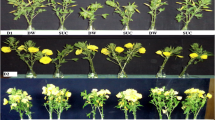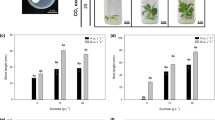Abstract
Phloem exudate prepared from induced cotyledons of Pharbitis nil (SD-PE) showed flower-inducing activity, and the exudate from cotyledons of P. nil grown under continuous illumination (CL-PE) expressed flower-inhibiting activity in apex cultures of P. nil. Following fractionation by ion exchange chromatography, the flower-inducing activity of SD-PE was located in the fraction adsorbed on anion exchange resin (Dowex); the flow-through (FT) fraction from anion and/or cation exchange resins used to separate CL-PE inhibited flowering. The flower-inducing and -inhibiting activities of both fractions from SD-PE and CL-PE were examined in detail. The FT fraction of SD-PE inhibited, and the Dowex fraction of CL-PE induced flowering. The flower-inducing activity of Dowex fraction of SD-PE was about 100 times higher than the same fraction of CL-PE, and the inhibiting activity of FT fraction of CL-PE was about 10 times higher than the same fraction of SD-PE. Therefore, flowering in P. nil may be controlled by a quantitative balance between flower-inducing and -inhibiting substances.
Similar content being viewed by others
References
Bernier G, Kinet J-M and Sachs RM (1981) The Physiology of Flowering, Vol I. Boca Raton: CRC
Cleland CF (1974) Isolation of flower-inducing and flowerinhibitory factors from aphid honeydew. Plant Physiol 54: 899–903
Cleland CF and Ajami A (1974) Identification of the flowerinducing factor isolated from aphid honeydew as being salicylic acid. Plant Physiol 54: 904–906
Evans LT (1960) Inflorescence initiation in Lolium temulentum L. 2. Evidence for inhibitory and promotive photoperiodic process involving transmissible products. Aust J Res 31: 555–566
Evans LT (1962) Day-length control of inflorescence initiation in the grass Rottboellia exaltata L. f. Aust J Biol Sci 15: 291–303
Evans LT and Wardlaw IF (1966) Independent translocation of 14C-labelled assimilates and of the floral stimulus in Lolium temulentum. Planta 68: 310–326
Guttridge CG (1959) Further evidence for growth-promoting and flower-inhibiting hormone in strawberry. Ann Bot 23: 612–621
Hander R, Westphal M and Behrens G (1949) Hemmung der Infloreszenbildung durch Langtag bei der Kurstagspflanze Kalanchoë blossfeldiana. Planta 36: 424–438
Hodson HK and Hamner KC (1970) Floral inducing extract from Xanthium. Science 167: 384–385
Imamura S (1961) The nature of inhibition of flowering by the leaves illuminated continuously during the inductive dark treatment of other leaves in short-day. Recent Adv Bot 2: 1287–1288
Imamura S and Takimoto A (1956) Flowering responses in Pharbitis nil as influenced by the removal of photoperiodically induced leaves. Bot Mag Tokyo 69: 817–818
Ishioka N, Tanimoto S and Harada H (1990) Flower-inducing activity of phloem exudate in cultured apices from Pharbitis seedlings. Plant Cell Physiol 31: 705–709
Ishioka N, Tanimoto S and Harada H (1991) Flowerinducing activity of phloem exudates from Pharbitis cotyledons exposed to various photoperiods. Plant Cell Physiol 32: 921–924
Jacobs WP (1980) Inhibition of flowering in short-day plants. In: Skoog F (ed) Plant Growth Substances 1979. Berlin: Springer-Verlag, pp 301–309
Kavon DL and Zeevaart JAD (1979) Simultaneous inhibition of translocation of photosynthate and of the floral stimulus by localized low-temperature treatment in the short-day plant Pharbitis nil. Planta 144: 201–204
King RW and Zeevaart JAD (1973) Floral stimulus movement in Perilla and flower inhibition caused by non-induced leaves. Plant Physiol 51: 727–738
Kopcewicz J (1972) Oestrogens in the long-day plants Hyoscyamus niger and Salvia splendens grown under inductive and non-inductive light conditions. New Physiol 71: 129–134
Kopcewicz J (1972) Estrogen in the short-day plants Perilla ocimoides and Chenopodium rubrum grown under inductive and non-inductive light conditions. Z Pflanzenphysiol 67: 373–376
Kopcewicz J and Porazinski Z (1974) Effects of growth regulators, steroids and estrogen fraction from sage plants on flowering of a long-day plant, Salvia splendens, grown under non-inductive light conditions. Biol Plant 16: 132–135
Lang A (1965) Physiology of flower initiation. In: Rubland W (ed) Encyclopedia of Plant Physiology. Berlin: Springer-Verlag, pp 1379–1536
Lang A (1980) Inhibition of flowering in long-day plants. In: Skoog F (ed) Plant Growth Substances 1979. Berlin: Springer-Verlag, pp 310–322
Lang A, Chailakhyan MK and Frolova IA (1977) Promotion and inhibition of flowering in a day neutral plant in grafts with a short-day plant and a long-day plant. Proc Natl Acad Sci USA 74: 2412–2416
Lincoln RG, Cunningham A and Hamner KC (1964) Evidence for a florigenic acid. Nature 202: 559–561
Lincoln RG, Mayfield DL and Cunningham A (1961) Preparation of a floral initiating extract from Xanthium. Science 133: 756
Murashige T and Skoog F (1962) A revised medium for rapid growth and bioassays with tobacco tissue cultures. Physiol Plant 15: 473–497
Ogawa Y and King RW (1979) Indirect action of benzyladenine and other chemicals on flowering of Pharbitis nil Chois. Plant Physiol 63: 643–649
Ogawa Y and King RW (1990) The inhibition of flowering by non-induced cotyledons of Pharbitis nil. Plant Cell Physiol 31: 129–135
Papafotiou M and Schwabe WW (1990) Studies on the longday inhibition of flowering in Xanthium and Kalanchoe. Physiol Plant 80: 177–184
Purse JG (1984) Phloem exudate of Perilla crispa and its effects on flowering of P. crispa shoot explants. J Exp Bot 35: 227–238
Zeevaart JAD (1976) Physiology of flower formation. Ann Rev Plant Physiol 27: 321–348
Zeevaart JAD, Brede JM and Cetas CB (1977) Translocation patterns in Xanthium in relation to long-day inhibition of flowering. Plant Physiol 60: 747–753
Author information
Authors and Affiliations
Rights and permissions
About this article
Cite this article
Kondoh, M., Fukusada, Y., Murakami, A. et al. Flowering may be controlled by a quantitative balance between flower-inducing and -inhibiting substances in Pharbitis nil. Plant Growth Regulation 28, 101–106 (1999). https://doi.org/10.1023/A:1006223629272
Issue Date:
DOI: https://doi.org/10.1023/A:1006223629272




